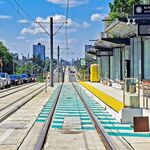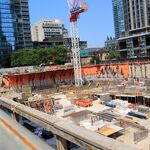Urban Sky
Senior Member
I was not speculating on what is possible with the current infrastructure, I was simply speculating on what might be possible with upgrading the existing ROW, while avoiding the need to construct punitively expensive HSR segments. Does this exceed the measurements budgeted in Metrolinx' RER plans? Possibly. Does this get anywhere near the eyewatering amounts HSR would cost? Most certainly not.Are they really running trains anywhere near 110 mph on the Weston Sub, or any sections of new track on the existing GO lines? The fastest I've seen is 60, and 90 for the entire system. All over the world, 80 mph (130 km/h) pretty much the standard for regional rail. I'm not sure it's feasible to run them that fast due to excessive at-grade crossing requirements now and the long acceleration times required to achieve those speeds. 110 mph is only 15 miles away from HSR speeds, so it might as well be classified as HSR (it's really higher speed rail, but it would be the fastest rail speed in Canada).
It's also important to note that upgrades to 110 mph on the Kitchener line will require upgrades to all at-grade crossings on the line, which I don't know if its covered by the existing RER package.
As for speeds, the FRA rules seem to be mostly the same for 110 mph as for 80 mph:
Source: FRA (2011, p.20) [First posted in Post #2807 of the VIA Rail thread]
Concerning Canada, the legal limit for level crossings seems to be 110 mph as well:
Source: http://laws-lois.justice.gc.ca/eng/regulations/SOR-2014-275/page-3.html#docCont [first posted in Comment #4080 of the VIA Rail thread]New Grade Crossing
Prohibition
Marginal note:Construction
29 A person must not construct a grade crossing if
- (a) the railway design speed would be more than 177 km/h (110 mph); or
- (b) the road approach of the proposed grade crossing would be a freeway, taking into account the characteristics set out for rural roads in Table 10-3 of the Grade Crossings Standards or the characteristics set out for urban roads in Table 10-4 of those Standards, as applicable.
There are regional trains all over the world which exceed 80 mph. Just to provide two examples from Germany: the DB AG Class 423 (the standard train for S-Bahn service, which is the German equivalent for RER) is operated at 140 km/h (87 mph), while the München-Nürnberg Express (a regional train using former Inter-City rolling stock) operates at 200 km/h (125 mph)...
Last edited:








